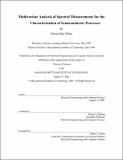| dc.contributor.advisor | Duane S. Boning. | en_US |
| dc.contributor.author | White, David A. (David Allan), 1966- | en_US |
| dc.contributor.other | Massachusetts Institute of Technology. Dept. of Electrical Engineering and Computer Science. | en_US |
| dc.date.accessioned | 2005-05-19T14:36:39Z | |
| dc.date.available | 2005-05-19T14:36:39Z | |
| dc.date.copyright | 2001 | en_US |
| dc.date.issued | 2001 | en_US |
| dc.identifier.uri | http://hdl.handle.net/1721.1/16792 | |
| dc.description | Thesis (Sc. D.)--Massachusetts Institute of Technology, Dept. of Electrical Engineering and Computer Science, 2001. | en_US |
| dc.description | Includes bibliographical references (p. 343-357). | en_US |
| dc.description | This electronic version was submitted by the student author. The certified thesis is available in the Institute Archives and Special Collections. | en_US |
| dc.description.abstract | The availability of affordable and reliable optical sensor technology and the abundance of data that these sensors now provide have created new opportunities to better characterize and control semiconductor processes in real-time. This thesis focuses on the analysis of multivariate methods and optical sensors for characterizing endpoint for two key processes: plasma etch and chemical mechanical polishing (CMP). To extract meaning information in real-time from the volumes of acquired optical sensor data, chemometric methods including principal component analysis (PCA) and partial least squares (PLS) are developed and tailored for characterizing endpoint and uniformity for each particular process. The results of this research include one of the first demonstrations of 1% low open area endpoint detection for a production etch process using a chemometrics-based estimator as well as comprehensive analysis and comparison of two innovative sensors, optical reflectance and IR thermography, for measuring wafer-level uniformity in CMP. During 8-inch copper polish experiments, the optical reflectance sensor is shown to demonstrate superior spatial resolution to IR thermography and provide spatial endpoint detection sufficient for reducing dishing and erosion during CMP. However, IR thermography is shown to be useful for characterizing thermal behavior and energy flow in the CMP process. This thesis concludes by proposing a dynamic thermal model for CMP, simulating the thermal behavior using Hspice circuit simulation software, and verifying this model against experimentally measured thermal behavior in CMP. | en_US |
| dc.description.statementofresponsibility | by David Allan White. | en_US |
| dc.format.extent | 357 p. | en_US |
| dc.format.extent | 3990082 bytes | |
| dc.format.extent | 3989731 bytes | |
| dc.format.mimetype | application/pdf | |
| dc.format.mimetype | application/pdf | |
| dc.language.iso | eng | en_US |
| dc.publisher | Massachusetts Institute of Technology | en_US |
| dc.rights | M.I.T. theses are protected by copyright. They may be viewed from this source for any purpose, but reproduction or distribution in any format is prohibited without written permission. See provided URL for inquiries about permission. | en_US |
| dc.rights.uri | http://dspace.mit.edu/handle/1721.1/7582 | |
| dc.subject | Electrical Engineering and Computer Science. | en_US |
| dc.title | Multivariable analysis of spectral measurements for the characterization of semiconductor processes | en_US |
| dc.type | Thesis | en_US |
| dc.description.degree | Sc.D. | en_US |
| dc.contributor.department | Massachusetts Institute of Technology. Department of Electrical Engineering and Computer Science | |
| dc.identifier.oclc | 50172257 | en_US |
